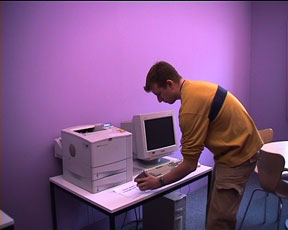Audio Networking
"The Forgotten Wireless Technology"
|
Overview
Audio Networking uses ubiquitously available sound hardware (i.e, speakers, soundcards and microphones) for low-bandwidth wireless networking. It has a number of characteristics which differentiate it from existing wireless technologies:
- It offers fine-grained control over the range of transmission by adjusting the volume.
- Walls of buildings are typically designed to attenuate sound waves, making it easy to contain transmission to a single room (unlike, for example, 802.11).
- It allows existing devices that play or record audio to be networked easily (e.g. voice recorders).
It is different from modem technology in that audio networking should work "over the air", where modems are designed to operate over telephone connections (which have good phase and noise properties compared to air).
Applications
Some of the applications we developed are outlined below, along with videos (click on the picture). For more details, read the publications as well.

|

|
|
The video above demonstrates an Audio Pick and Drop Interface: an Internet URL is recorded into a PDA via a standard computer speaker. The URL is later retrieved from the PDA by playing it into the computer, and also printed by carrying the PDA to a print server and playing back the recorded identifier.
A great advantage of this is that any cheap voice recorder is capable of carrying the audio information (e.g. mobile phone, PDA, dictaphone, etc).
|
One of the more interesting discoveries during this research is that most computer soundcards do not have good anti-aliasing filters fitted, resulting in them being able to send and receive inaudible sound at upto 24 Khz (assuming a 48 KHz soundcard).
We used this to create a set of inaudible location beacons that would allow laptop computers to simply listen using their microphones and discover their current location without any advanced equipment being required!
|

|

|
|
We devised a scheme of encoding data into mobile phone ringtones while still making them sound pleasant to the ear. This allows us to use the phone network for the video example above: an SMS 'capability' is transmitted to a phone, which can be played back to gain access to a building.
Since the data is just a melody, this allows for uses such as parents purchasing cinema tickets online for their children (who dont own a credit card), yet still allowing the children to gain access to the cinema by playing the ringtone capability back (via their mobile phones, common among children).
|
We observed that audio networking allows URLs to be easily sent over a telephone conversation, and retrieved over a normal high bandwidth connection by the recipient.
This gets over the real awkwardness of "locating" someone on the Internet, which is rife with restrictive firewalls and Network Address Translation which is destroying end-to-end connectivity. In contrast, it is trivial to locate someone on the phone network given their telephone number, but harder to perform high bandwidth data transfers (which the Internet excels at).
|
Sound Samples
|
Melodic Data Transmission
The following represents a 96-bit packet encoded melodically using the baroque theme. The melody was transferred to a Nokia 3210 mobile phone as a ring-tone. The samples below are recorded by holding the mobile phone against a microphone:
|
DTMF Data Transmission
Examples of standard DTMF touch-type tones at various bit-rates:
This encoding is particularly well suited to being transmitted down telephone lines, since the phone network already uses it for dialling numbers.
|
On-Off-Keying Data Transmission
Examples of OOK (On-Off-Keying) modulated over a 10kHz carrier at a variety of bit-rates.
In each case a 256-bit packet is transmitted:
OOK works well for close-quarters, relatively high-bandwidth audio transfers rather than across a room.
|
Publications
-
Context-Aware Computing with Sound
Anil Madhavapeddy, David Scott, and Richard Sharp
In the Proceedings of the Fifth International Conference on Ubiquitous Computing (UBICOMP-2003), October 2003.
[PDF]
People
|